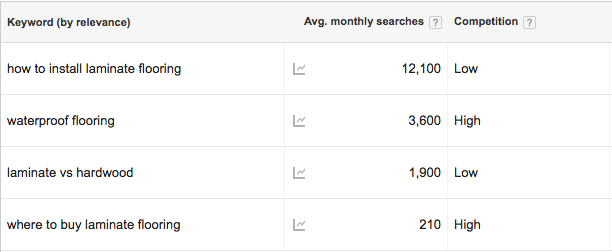A few weeks ago, we published a blog post about…well, blogging. In it, we explored the benefits of blogging for building materials companies and a few ways you could improve your own blog with strategy and insight.
Here’s the thing: What if you don’t even know how to start blogging?
This type of content creation, while not totally unheard of, is fairly uncommon in the building materials space. You simply don’t run into many building materials blogs out there. There’s both a good reason for that, and an advantage.
The reason is fairly straightforward. Many building materials manufacturers haven’t yet joined the 21st century where content marketing is a valuable digital asset. And even if they are aware that promoting their brand online can be profitable, they don’t fully “get it.” Most blogs out there are personal in nature and there are so many of them, so what’s the point, right?
I have to respectfully disagree with that perspective. And it’s that exact mindset that can actually work to your benefit.
Think about it: If your competitors aren’t blogging, but your customers are seeking information about building materials on the Web, there’s a huge opportunity ripe for the picking.
So over the next few weeks, we’re going to break it all down into an actionable plan you can start implementing right away. We’ll explore:
- What to write
- How to write it
- How to distribute it to drive traffic to your site
This brings us back to my original question. Where do you start? It’s one thing to acknowledge that you should blog, and another thing to know how do it—and do it right.
Let’s start with figuring out exactly what to write. To determine this, it’s important to ask yourself two questions:
- What am I the expert in?
- What do my customers want to know?
Once you figure out the answers, coming up with useful blog fodder will become way easier.
Write What You Know—And What They Don’t
Obviously, you’re the expert when it comes to your own building products. Whether you produce flooring materials, windows and doors, or advanced insulation and coatings, there’s no one else that can speak as knowledgably about what you do than you.
Write For The Everyman
The problem is, a lot of us tend to take shortcuts when talking about something we know inside and out. It’s easy to assume that the information will make as much sense to everyone else as it does to us because we’ve had the time to steep our brains in the subject matter.
But your prospective customers might not know everything there is to know about your specific products. Sure, they might know enough about your type of product—for example, a contractor doesn’t need to be educated on how to install windows because he’s been doing it for years. But he might not know about the ways your windows are better than the other guy’s.
This counts doubly if your target audience comprises homeowners and DIYers who are (despite their best efforts) not professionals. They’re going to need more hand-holding, and you’re going to have to make sure you explain things on your blog in their language.
Tap Your Sales Team
If you have a salesforce at your company that deals with prospects on a daily basis, you can enlist their help by finding out what questions they are frequently asked. This will give you insight into which facets of what you do are eluding people.
Take that information and make a list similar to an FAQ. Each one of those items is a potential blog post in which you can demystify any topic for your audience.
Keep Your Finger On The Pulse
There are a lot of “101”-type topics you can fill your blog with, and most of that content will be evergreen, meaning that it will always be relevant and people will always be able to find it when they search for certain keywords (more on that in a bit).
That being said, it can be extremely beneficial to keep an eye and ear out about what’s going on in the world. If you can keep up and respond to changes and trends in the industry in a timely fashion, you can benefit in a few ways:
- You’ll be proving that you’re active and in touch.
- Visitors will view your blog as a source for current news and trends.
- You can position yourself as an authority in your space.
This can include writing about quarterly market reports, observing relevant trends either in your direct industry or the industry of your audience (i.e. construction, home improvement, etc.), and even responding to other experts’ articles with your own opinions.
Bear in mind, however: If you can’t keep this up with some level of consistency and frequency, it’s probably better to stick to evergreen topics.
Find The Keyword Sweet Spot
At this point, you might have started a short list of some topics that have already sprung to mind while exploring this topic. If so, great!
But let’s stop and think more critically about this for a second.
If you can come away from a marketing meeting with your sales team with a whole laundry list of questions they get asked all the time, you’re off to a fantastic start. But you’ll need to investigate if they’re all worth taking the time out of your busy day to answer on your blog.
That’s where the Keyword Sweet Spot comes into play.

To determine if a blog topic you have in mind is worth writing about, you need to ask yourself:
“Is it relevant to my building materials business?”
This one is pretty easy, because if the answer is anything remotely close to “no,” then you should just throw that topic right out the window.
Everything you write about should relate back to your products in some way. It’s a great and noble thing to want to be the expert in All Things Building Materials, but if you’re a maker of, say, stone tiles, it’s likely that you have no business writing about solar panels or lumber.
Stick to what you know and own it.
“Is it a popular topic people are searching for?”
There isn’t any point in answering questions that no one is asking, is there?
“But Jess,” I hear you say to your screen. “You just told me to write down what the sales guys said people are asking them every day, so they are asking!” And you’re absolutely right, but it’s a little more complex than that.
What people ask on the phone isn’t always what they ask Google.
You need to decide what your goals are for blogging. If the point is to have readily available links for the sales team to shoot out to prospects, then by all means, write the heck out of those FAQ posts. But if your goal is search engine optimization (SEO), the question of popularity becomes very important.
Of course, you can’t talk about popularity without talking about competition.
“How fierce is the competition for this keyword?”
Remember the “other guy” I mentioned earlier? It would behoove you to keep an eye on him in this regard. After all, no one markets products in a vacuum.
Your competition for keyword rankings isn’t always going to be your direct competition for sales—that’s often a matter of sheer locality, whereas rankings are determined by a host of factors such as content quality, keyword density, domain authority and reputation, users’ browsing and search history, and much, much more.
Then you have to take into account paid search and how much everyone is bidding on the prime real estate at the top of search engine results (if you are inclined to play on that field).
There are several tools out there like SEMrush, Google Keyword Planner, and many more that can give you a ballpark estimate of both how many people search for any given keyword on a monthly basis and how intense the competition is. Even some marketing automation tools like HubSpot offer these stats.
For example, let’s say you produce laminate flooring and one of your buyer personas is DIYers. You’ve got a list of topics in mind based on your preliminary research. You run a few keywords that you think these home improvers might be searching for through Google Keyword Planner to see what sticks:

According to Google, not many people are searching for “where to buy laminate flooring,” and yet there’s a high amount of organic and paid search competition—probably from big box stores trying to get customers through their doors.
This means it will be tough to rank for something not a lot of folks are looking for to begin with.
The obvious winner is the long-tail keyword “how to install laminate flooring.” Thousands of people are searching for it monthly and yet, by Google’s estimation, there aren’t that many sites out there with content answering the question.
If your company not only produces, but sells laminate flooring, this is the perfect opportunity to strut your stuff. You can educate people through your blog (and other content) on how to install laminate flooring, and then explain why your laminate flooring works best and drop in a call to action (CTA) to browse your product catalog or contact one of your sales reps.
Own that Keyword Sweet Spot!
Conclusion
Your mind is probably swimming by now—hopefully with a ton of ideas for what to start writing about on your blog. Armed with a solid list of topics that you’re confident in and that are statistically sound, you have half the battle won.
Now it’s time to write the dang thing.
Of course, the word “write” tends to send a shiver down may people’s spine, but don’t worry. In our next post, we’re going to go over some helpful tips that will help not only get your creative juices flowing, but give you the structure you’ll need to crank out blog posts both proficiently and efficiently.
Stay tuned!

